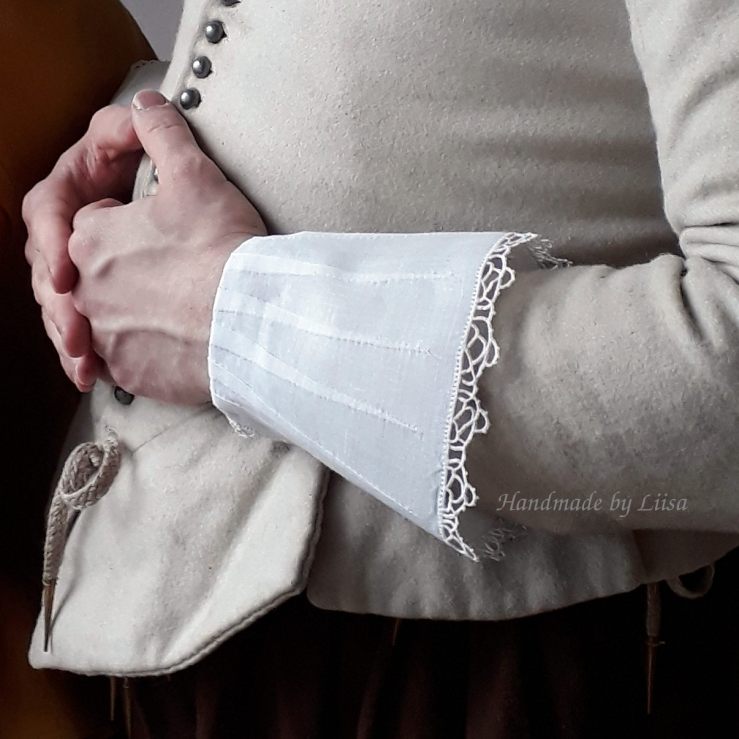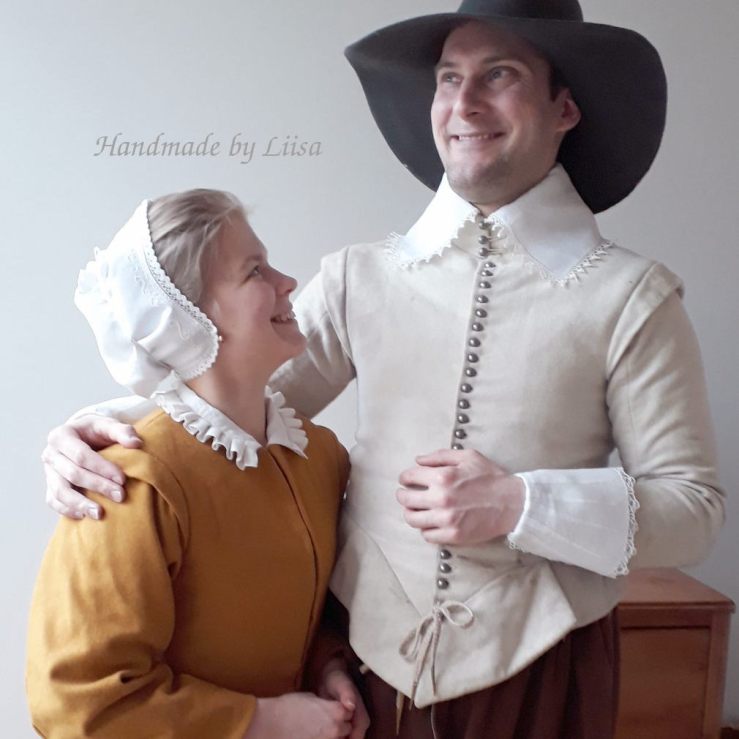
Here’s my son and his girlfriend posing in their 17th century re-enactment gear 🙂 Both have hand sewn their outfits themselves, out of wool and linen cloth with unbleached linen thread and using the patterns and methods of that era. The coif or cap and my son’s cuffs and collar are my contribution. (See reference books at the end of the post)
*
Historianelävöittäjäpoikani ja hänen tyttöystävänsä poseeraavat 1600-luvun vaatteissaan, jotka he ovat itse valmistaneet villa- ja pellavakankaista. Vaatteet on ommeltu käsin valkaisemattomalla pellavalangalla ja asut on toteutettu ajanmukaisia kaavoja ja menetelmiä käyttäen. Minä olen saanut tehdä naisen myssyn sekä pojalleni kauluksen ja kalvosimet. (Lista lähteinä käytetyistä kirjoista postauksen lopussa)
 The coif is sewn and decorated with bleached linen thread and using an old linen sheet for material. The patterns is adaptated from several coifs in Janet Arnold’s book Patterns of Fashion 4. The machine made lace just about passes for a hand made bobbin lace…
The coif is sewn and decorated with bleached linen thread and using an old linen sheet for material. The patterns is adaptated from several coifs in Janet Arnold’s book Patterns of Fashion 4. The machine made lace just about passes for a hand made bobbin lace…
*
Myssy on ommeltu Janet Arnoldin Patterns of fashion 4 kirjan ohjeita mukaellen noin sata vuotta vanhasta lakanakankaasta käyttäen valkaistua pellavalankaa. Myssyn pitsi on konevalmisteista, vähän käsinnyplätyn oloista…
The back part of the top seam is shaped by gathering it through small loops. On the bottom edge there’s a drawstring casing for the narrow silk ribbon. A simple embroidered pattern made with chain stitch and eylet holes follows the front edge of the coif.
*
Myssyn yläsaumaan on taakse tehty pieniä lenkkejä mistä se on rypytetty malliinsa. Alareunassa on kuja kapeaa silkkinauhaa varten. Myssyn etureunaa koristaa yksinkertainen ketjupistokuvio ja napinläpipistoin tehdyt pyörylät.

This is a length of bobbin lace I made as an edging for the coif but didn’t have enough time to get it ready for this one. You can see how delicate it is next to the coif in the picture above and there is the next model already planned. The pattern is from the same series of books by Gilian Dye as the pattern for the lace on the collar. It’s a simple and narrow lace as the accessories have to be in line with the rest of the gear. Before my young friends rise to the upper bourgoisie (and make some befitting costumes), I have to restrain my desire to make more complicated laces! 🙂
*
Yllä pätkä kapeaa ja yksinkertaista nyplättyä pitsiä joka oli tarkoitus laittaa myssyn reunaan, mutta myöhästyi. Ylemmässä kuvassa näkee kuinka herkkää se on valmiin myssyn vieressä. Seuraava myssy onkin jo suunnitteilla. Pitsimalli on samasta kirjasarjasta kuin kauluksen vähän leveämpi pitsi, ja siis alkuperäisen ajan mallin mukaan tehty. Asusteiden pitää olla tietysti linjassa muitten vaatteiden kanssa, joten ennen kuin nuoret ovat saaneet ylemmän porvariston tai aatelisten asunsa valmiiksi, on minun tyydyttävä tekemään yksinkertaisempia pitsejäkin! 🙂

There are special ear irons inside the coif to which the sides are attached with pins to keep the headdress in place and the ears inside. The silk ribbon gathers the bottom edge, is wound on opposite sides of the coif around the lady’s bun and tied at the top (or bottom if it’s long enough). There’s a nice article on ear irons (and lots more) in the Atelier Nostalgia blog.
*
Pellavaisen myssyn alla on erityiset korvaraudat pitämässä myssyä paikallaan niin, että korvat pysyvät sen sisällä. Myssy kiinnitetään pienillä neuloilla korvaraudan päihin korvien eteen. Silkkinauhalla kiristetään alareuna, laitetaan ristiin alhaalla ja sidotaan ylös nutturan ympäri. Hyvä artikkeli korvaraudoista ja aikakauden vaatteista on Atelier Nostalgia blogissa.
 ,
,

The lace on the collar, which I wrote about in a previous post, is a replica of an authentic 17th century lace from a book by Gilian Dye. The cuffs are decorated with needle lace, more of those here.
Yksinkertaisen kauluksen reunaan nypläsin 1600-luvun mallin mukaan pellavaista pitsiä. Siitä lisää tässä postauksessa. Kalvosimissa on ommeltua pitsiä ja niistä postaus täällä.

The kirtle or petticoat is worn with a linen shirt, a pleated partlet and an apron. But as I was told, no respectable woman would be seen like this outside her house without the jacket!
*
Liivihameen alla on pellavainen yksinkertainen paita, ja päällä esiliina sekä partlet eli irtokaulus, joka nyöritetään rinnan ympäri ja kiinnitetään vielä neuloilla. Tässä asussa ei kuulemma kunniallisen naisen sopinut näyttäytyä kodin ulkopuolella vaan päälle puettiin vielä röijy.

Here they are, looking like they just dropped in from the 17th century 🙂
*
Aikahyppäys 1600-luvulle 🙂
References for the clothing:
Janet Arnold, Patterns of Fashion 3: The Cut and Construction of Clothes for Men and Women C. 1560-1620. Macmillan 1985.
Janet Arnold, Patterns of Fashion 4: The cut and construction of linen shirts, smocks, neckwear, headwear and accessories for men and women c. 1540-1660. Macmillan 2008.
Ninya Mikhaila and Jane Malcolm-Davies, The Tudor Tailor, Reconstructing 16th-century dress. First published in 2006. The Tudor tailor.
Edited by Susan North and Jenny Tiramani, Seventeenth-century Women’s Dress Patterns, Book one. Bublisher V&A .
Reference for bobbin lace of coif and collar:



